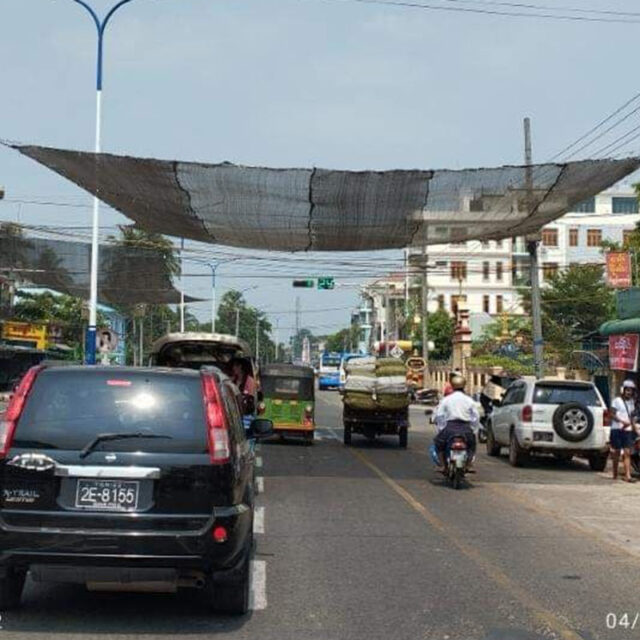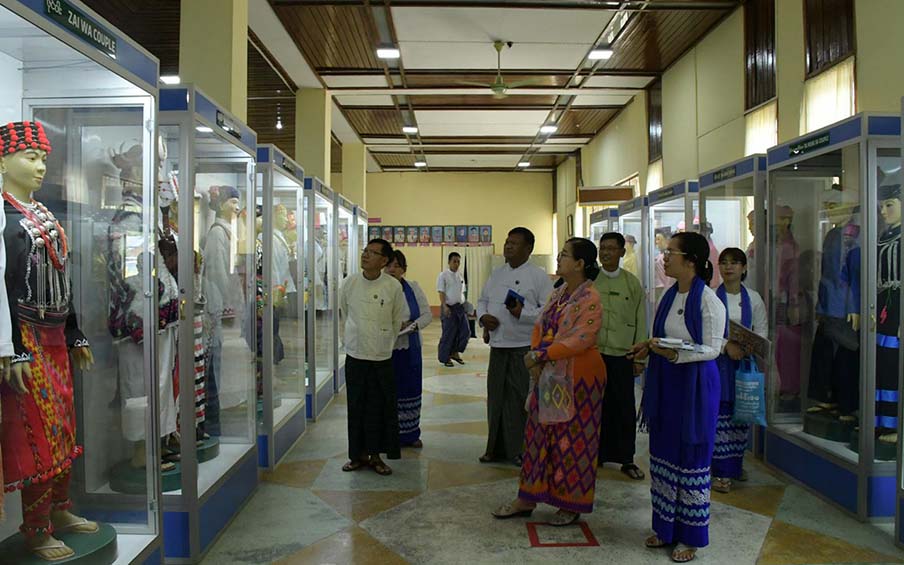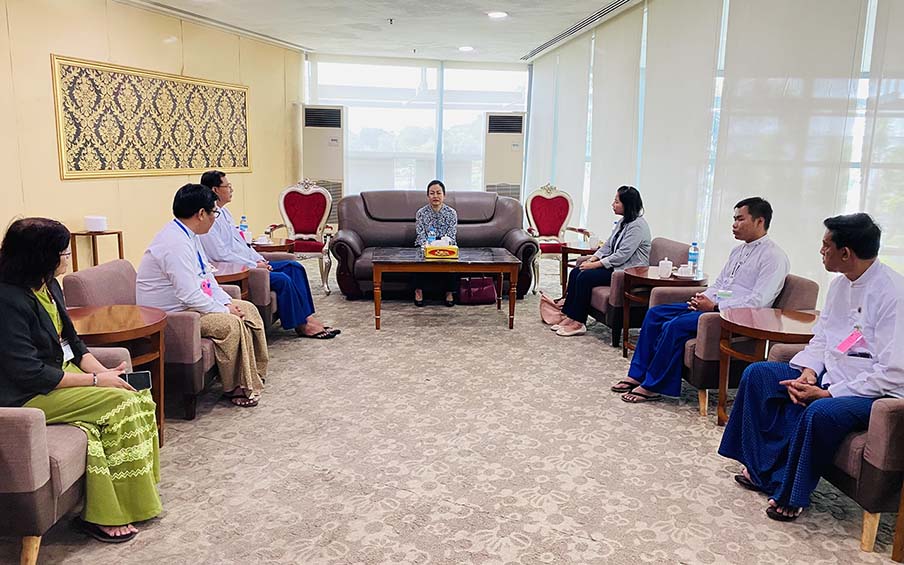Ko Myint Zan, a man of nostalgia, reminiscences about the days when he used to sit at the tea shop in his native town, engrossed in deep conversations with friends. These nightly gatherings were characterized by discussions about work, family, and shared literary experiences. The tea shop became a haven for the exchange of thoughts and emotions, fostering warmth and camaraderie. Despite occasional arguments, the bond between friends remained intact, and those moments at the tea shop became cherished memories.
However, life took Ko Myint Zan to another town in pursuit of livelihood, and a decade has passed since he left his native town. In his new abode, he has forged new friendships, yet the dynamics of social interaction have undergone a drastic transformation. Unlike the days of the tea shop, the contemporary social scene is dominated by the omnipresent glow of smartphones. The once-intimate gatherings have given way to a disconnected existence, with people engrossed in virtual realms, oblivious to the faces around them.
The tea shop, once a hub of interpersonal connections, has lost its charm for Ko Myint Zan. He laments the fact that conversations have been replaced by the incessant tapping of screens, as individuals immerse themselves in the digital world. The disappointment runs deep, prompting him to withdraw from the tea shop scene altogether, finding solace in the company of books within the confines of his home.
In the present era, smartphones have become ubiquitous, providing everyone with unprecedented access to the internet. While Ko Myint Zan refrains from outright condemnation of activities like using Facebook and playing games, he does express concern about the excessive indulgence in these digital pastimes. The negative consequences, he argues, are multifaceted: financial strain, time depletion, and the detrimental impact on eyesight.
The financial aspect is significant, as the cost of smartphones, internet plans, and in-app purchases can accumulate rapidly. Time, a resource that cannot be replenished, is squandered on endless scrolling and gaming. Moreover, prolonged screen time poses a threat to eyesight, a precious and irreplaceable faculty. Ko Myint Zan emphasizes the irrevocable nature of these consequences, urging caution in the pursuit of digital gratification.
Yet, it is not merely the financial and temporal aspects that concern Ko Myint Zan. The erosion of human connection is equally troubling. In a world captivated by the virtual, the authenticity of relationships is challenged. The information shared on platforms like Facebook is not always reliable, with fake news proliferating, and individuals resorting to deceptive tactics for personal gain. The trustworthiness of online interactions becomes a critical issue, requiring users to discern between reality and manipulation.
The insidious nature of excessive internet use is further compounded by its impact on interpersonal relationships. In the pursuit of digital engagement, individuals often neglect those physically present around them, including family and close friends. The allure of the virtual world takes precedence over genuine, face-to-face interactions. Ko Myint Zan underscores the irony that, in times of trouble, it is the immediate circle of family and friends who offer support, not the distant online connections.
The heart of Ko Myint Zan’s lament lies in the diminishing warmth and unity among those sitting at a shared table in the tea shop. The camaraderie, friendliness, and mutual understanding that once defined these gatherings have dissipated, leaving behind a palpable sense of distance. Warm chats have become a rarity, replaced by the sterile glow of screens and the silent tapping of fingers.
In essence, Ko Myint Zan’s yearning for the days in his native town reflects a broader societal shift. The digital age has brought about unparalleled connectivity, yet it has also sown the seeds of disconnection. The very tools designed to bring people together have, in some ways, driven them apart. The challenge, then, is to strike a balance between the virtual and the real, to leverage technology without sacrificing the depth and authenticity of human relationships.
As we navigate this delicate equilibrium, Ko Myint Zan’s narrative serves as a poignant reminder of the importance of human connection. The tea shop, once a symbol of shared experiences and genuine interactions, stands as a testament to what is at stake in the face of technological progress. It calls upon us to reflect on the nature of our digital engagements and the impact they have on the fabric of our interpersonal connections. Ultimately, in the pursuit of progress, may we not lose sight of the essence of being truly close, even in a world that seems increasingly distant.
Ko Myint Zan’s poignant narrative serves as a compelling lens through which to contemplate the profound societal changes wrought by the digital age. As we delve into the intricacies of his experiences and reflections, a profound sense of loss and nostalgia emerges — a yearning for a time when human connections were forged in the crucible of face-to-face interactions, unburdened by the omnipresence of screens and the digital realm.
The tea shop, once a vibrant crucible of shared experiences and genuine connections, stands as a metaphor for the collective human experience that is seemingly slipping away. Ko Myint Zan’s recollections transport us to a bygone era where conversations flowed effortlessly, discussions about work, family, and literature unfolded organically, and the warmth of camaraderie filled the air. The loss of such moments is palpable in his words, inviting us to reflect on the intangible but irreplaceable value of physical presence and authentic engagement.
The trajectory of Ko Myint Zan’s life, from the familiar confines of his native town to the unfamiliar landscape of a new town, mirrors the broader societal shift towards digital interconnectedness. The allure of the digital realm, symbolized by the glow of smartphones, has replaced the nuanced dynamics of personal interactions. The once-intimate gatherings at the tea shop have given way to a disconnected existence, where faces are obscured by screens, and genuine conversations have become a rarity.
This shift prompts contemplation on the multifaceted nature of technological engagement. Ko Myint Zan, while refraining from outright condemnation of digital activities, draws attention to the excessive indulgence in platforms like Facebook and gaming. The contemplation extends beyond mere critique, delving into the profound consequences of this digital immersion: financial strain, temporal depletion, and the adverse impact on physical well-being.
The financial aspect resonates as a societal concern. The relentless pursuit of the latest smartphones, data plans, and in-app purchases not only places a strain on individual budgets but also contributes to a consumer-driven culture that values the tangible over the intangible. Ko Myint Zan underscores the importance of recognizing the irrevocable nature of these consequences, urging a reevaluation of our priorities in the pursuit of digital gratification.
Time, that most precious and irreplaceable resource, emerges as another focal point in the contemplation. The hours spent on endless scrolling and gaming represent a significant investment that could otherwise be directed toward meaningful endeavors or genuine human connections. The temporal dimension of digital engagement raises questions about the true cost of our virtual pursuits and prompts introspection on the nature of fulfillment in a world dominated by screens.
Furthermore, Ko Myint Zan draws attention to the erosion of human connection — an aspect that transcends financial and temporal concerns. The authenticity of relationships in a virtual world is questioned, with fake news and deceptive tactics undermining the trustworthiness of online interactions. This contemplation delves into the dichotomy between the virtual and the real, emphasizing the importance of discernment in navigating the intricacies of the digital landscape.
The impact of excessive internet use on interpersonal relationships forms a poignant facet of Ko Myint Zan’s lament. The neglect of those physically present in favor of digital engagement speaks to a larger societal trend where immediate connections take a backseat to virtual allure. This contemplation extends an invitation to reflect on the irony embedded in this shift — while online connections may offer a semblance of support, it is the tangible presence of family and close friends that proves steadfast in times of trouble.
The heart of Ko Myint Zan’s reflection lies in the dwindling warmth and unity among those once bound by shared experiences. The tea shop, once a symbol of camaraderie and mutual understanding, now stands as a testament to the societal disconnection brought about by technology. Warm chats, once commonplace, have become a rarity, replaced by the sterile glow of screens — a silent testimony to the broader societal shift from the tangible to the intangible.
In essence, Ko Myint Zan’s yearning for the days in his native town prompts a contemplation of the broader implications of the digital age. The narrative serves as a poignant reminder of the delicate balance required to navigate the intersection of the virtual and the real. As we ponder the significance of human connection in the face of technological progress, the tea shop becomes a symbol of what is at stake — a call to reflect on the nature of our digital engagements and their impact on the fabric of our interpersonal connections.
This contemplation, inspired by Ko Myint Zan’s narrative, urges us to consider the essence of being truly close in a world that appears increasingly distant. It prompts introspection on the evolving nature of our relationships, the value we place on authenticity, and the role technology plays in shaping the human experience. As we navigate this delicate equilibrium, may we heed Ko Myint Zan’s poignant reminder and strive to preserve the richness of genuine connections amidst the digital tide.
The Erosion of Human Connection in the Digital Age
- January 06, 2024
- 157













